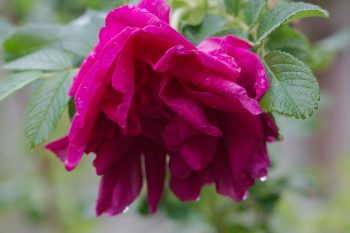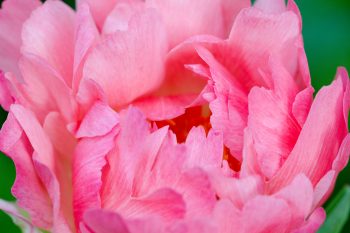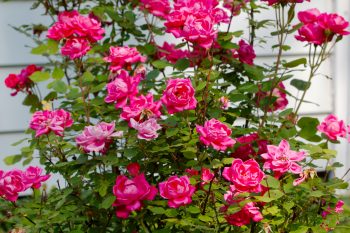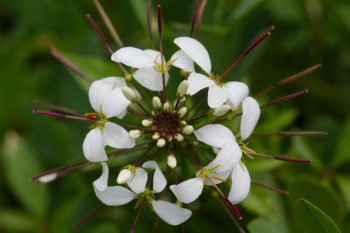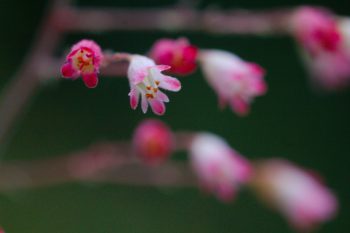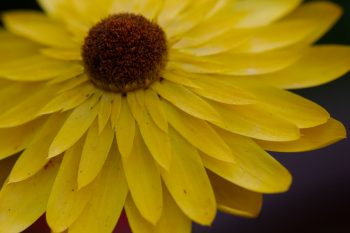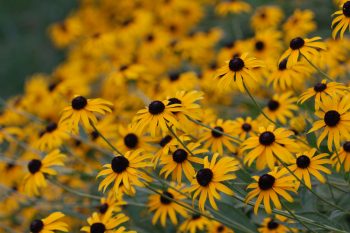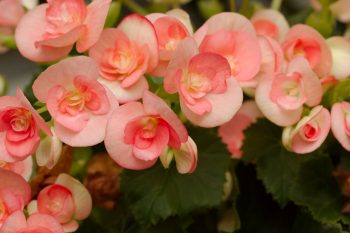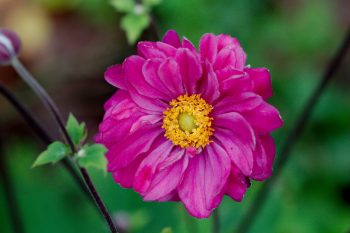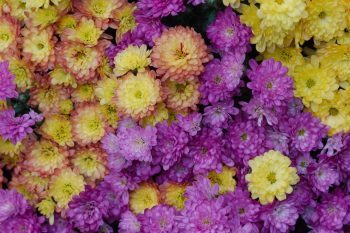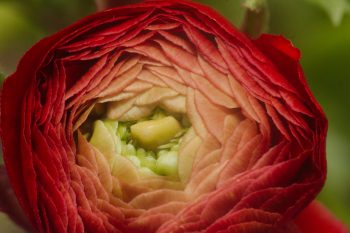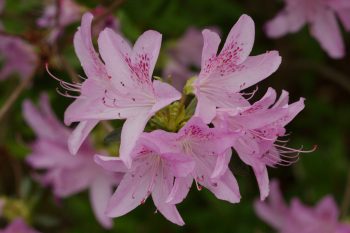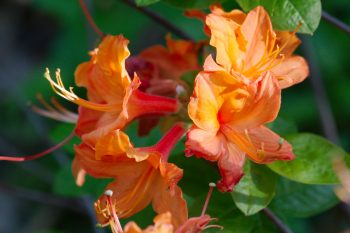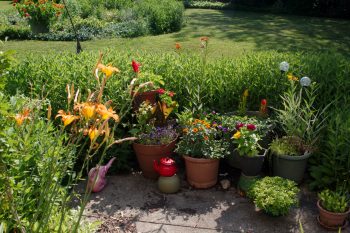My roses have had a rough few years. Three of them outright died in the last twelve months and I’m not entirely sure why. This one, a hybrid rugosa named ‘Roseraie De l’Hay’ lost a lot of stems but is still hanging on and has just started to bloom. The stems are relatively thin and the heavy flowers are too much for them, so they face pretty much downwards, especially after a rain. Like most rugosas, this rose has a really wonderful scent and the leaves are a beautiful green, generally untouched by any disease.
Tagged With: Blooms
Roseraie De l’Hay
Peony ‘Coral Sunset’
This is one of three peonies that I planted in 2014, named ‘Coral Sunset’ that are growing will in the back garden. I’m a big fan of peonies and if I had a lot of space I might devote and entire garden room to them. There are both herbaceous and woody stemmed peonies and the are both worth growing. They do take a while to get established but they don’t really require much care. The reward in the huge, brightly colored flowers every spring. There is a nice peony garden at Seneca Creek State Park, if you are interested. I haven’t had a chance to go this year and it isn’t looking like I will, but it’s worth a peek, if you can get there when they are in bloom.
Landscape Rose
I really like roses and I’ve posted photos of them here fairly often, trying to get each of my roses featured at least once a year. I also like to visit my friend Nick, who often opens his rose garden on Memorial Day weekend. He didn’t this year, for personal reasons, but I thought I’d post a rose photo, anyway. The rose that’s blooming that I haven’t featured yet this year is a landscape rose that our neighbor gave me a few years ago. It’s growing in a nice, sunny spot behind our garage and is quite happy there, blooming profusely (as you can see). I’m not as big a fan of these roses as I might be, mainly because they have little to no fragrance. But I can’t fault them in terms of blooming and ease of care. If you want a rose that will bloom all summer and which you can basically ignore, this is probably the rose for you. They really are quite spectacular when they really get going.
Cleome ‘Senorita Blanca’
On Sunday, as I mentioned, we went to Stadler Nursery in Laytonsville. Cathy bought a few things, including two Cleome plants, one white and one very pale pink. The white one, shown here, is called ‘Senorita Blanca’ and the other is ‘Senorita Mi Amor’. We’ve had Cleome ‘Senorita Rosalita’ in the past and these are (I assume) related plants with different coloration. My understanding is that they are sterile and will not self-seed, which is both good and bad. Annuals that do self-seed can become a real nuisance and get out of control. But some, if they only just manage to hold on, are really nice. Nigela is a good example of the latter. In our experience, it just self-seeds enough that we have it for a few years before needing to plant more. Other annuals, of course, go totally native and sterile plants are a real boon.
Heuchera sanguinea
We’ve had coral bells (Heuchera sanguinea) growing in our garden and in containers pretty much since we have been able to have a garden. It’s not the sturdiest of plants and we’ve had to replace them from time to time. I may be forgetting something but I think this is currently our only plant, growing in a container in the driveway. It’s fairly happy, probably because the containers get watered more regularly throughout the summer than the in-ground plantings. Also, although this gets a bit of direct morning sun, it’s in bright, open shade by early afternoon so it doesn’t bake. It seems to be happy and it blooms quite freely, which is nice.
Asclepias curassavica Orange
This butterfly weed, Asclepias curassavica, is also known as blood flower. Cathy recently bought a few plants in both orange (this one) and all yellow. Sadly, it is not hardy enough for in-ground planting as a perennial here, but it should do well in containers and brighten up the back patio. This one is in a container right outside our kitchen door and looks great against the green backdrop of Rudbekia growing around the patio. I especially like the bi-color nature of this one, although the all-yellow variety is nice, too.
Strawflower
Cathy bought some strawflower, also known as golden everlasting (Xerochrysum bracteatum) this spring and has it in a container on the back patio. They are quite bright and lovely to see from the kitchen door. As the flowers open, the center is a bright orange that complements the yellow of the stiff petal-like bracts. As the flower ages, the central disk turns brown, as seen here, but the bracts remain. This gives the flowers their “everlasting” common name. They are already basically dry, so they don’t dry out and turn brown, but rather keep their yellow color. Apparently in their native Australia they grow in sweeping drifts in open grassland, which must be quite beautiful indeed.
Blackberry Lily (Iris domestica)
The blackberry lilies (Iris domestica and formerly Belamcanda chinensis) have started to bloom in the garden. We originally got this when I collected some seeds and planted them at our old house. We brought some here with us in 2006 and they have really taken hold. We sprinkle the seeds around and let them grow where they will. They aren’t nearly so aggressive as to be a problem and they are so pretty. I had a picture of the buds recently but this is the flower. They open in the morning and each individual flower only lasts a day, but they are born in profusion and soon we’ll have dozens of them in bloom, scattered around the yard.
Red Roses
Cathy’s mom had a visit today from an old friend and her husband. They brought these flowers, which was nice, and they looked lovely in the late afternoon sun coming in through the dining room windows. I took pictures of them from a bunch of different angles. Deep reds like this are a challenge for my digital camera and they tend to overwhelm the sensor but this one turned out pretty well. No disrespect meant towards Canon. It’s a really intense color and it came out well. Our eyes are such remarkable organs with the ability to see such a huge range of color and brightness that it isn’t actually surprising that technology is still trying to get there. We’ve come a long way, though.
Black-eyed Susans
I’ve posted pictures that have Black-eyed Susans in them but today’s photo is just of them. To say we have a few is a bit of an understatement. The reality is that we have let them run riot and there are a lot of them in the back yard. They add so much color that we don’t really mind, especially around the patio. We’ve managed to keep one large and one small walkway through them, so we can get out into the yard. They are pretty popular with the pollinators, attracting bees, flies, moths, and butterflies. One interesting thing about them is the photos I take always look bluer than they look in real life and I have to correct for that. On the other hand, the leaves really do have a fair amount of blue in their green.
Winter-flowering Begonia
With more than 1,800 species, the genus Begonia is one of the largest genera of flowering plants. That doesn’t take into account a multitude of hybrids and cultivars. I have no idea what this variety is, but it’s a pretty, winter-flowering begonia and that’s all that really matters. There are hardy begonias but this isn’t one of them. So, it’s on a table in our dining room and provides some color, along side two deep purple African violets and sheltered by a large (and growing) fiddle-leaf fig (Ficus lyrata) and a fairly old pathos plant (Epipremnum aureum).
Japanese Anemone
We’ve admired anemones in other peoples’ gardens for years and on occasion we’ve tried to grow them in ours but so far, nothing has taken. Cathy bought this one the other day from Stadler Nursery in Laytonsville and we’re going to give it another try. They really are lovely flowers and pretty plants in general. Hopefully we find the right spot for it where it can thrive and where we can enjoy it on a regular basis for years to come.
Chrysanthemums
Although chrysanthemums (a.k.a. mums) are fairly hardy herbaceous perennials, most of us grown them as annuals, bringing them out in the fall to add color to an otherwise less colorful garden. The Rudbekia are done blooming and even the Buddleia are starting to fade. There are still roses on the more ever-blooming varieties, but most of the summer flowers are done for the year. Enter the humble and yet lovely chrysanthemum. We have a few in pots that have been given or that we bought. This one is sitting outside our front door and greeting us as we leave and again when we return home. Who could ask for anything more?
Ranunculus asiaticus
While she was in Alaska from July to December, Dorothy got a job at a florist shop. She’s been exposed to flowers and plants to one degree or another all her life, having been dragged to various botanical gardens and arboreta. More recently she has come to appreciate them more than she did as a child. Nevertheless, her time at the florist has served to increase her love of flowers. This is a Ranunculus asiaticus, the Persian buttercup, and Dorothy brought home a bouquet of them for the dining room table. They are quite beautiful and I love the many overlapping petals of the deep crimson blooms.
Ranunculus
The Ranunculus that I photographed on January 17 continues to deliver. The flowers have opened up and are bright orangy-red with interesting centers. In another day or two they’ll be finished, I think, but we’ll get a little more enjoyment out of them. This time of year, flowers on the table are a nice extravagance. It’s actually getting a bit warm for this time of year and the forecast is for warmer still for a little while. I have no doubt that winter will return before long, though, and we’ll want to stay indoors.
Maple Blossoms
We happened to be in northern Virginia this afternoon to meet some friends for brunch. We got there a little early so we walked in a park near the restaurant and I took some pictures of three different plants that are in bloom. First, and seen here, are maple blossoms. I think this is a silver maple (Acer saccharinum) but I didn’t take the time to identify it carefully. I’m pretty sure it isn’t red maple (Acer rubrum) but it could be a sugar maple (Acer saccharum) or a number of other species. It’s a bit early even for the early trees to be blooming but it’s been such a mild winter so far, I’m not terribly surprised. It may get cold yet, of course. It’s still only mid November.
Flowering Almond
This is the little flowering almond growing near the corner of our garage. It’s done pretty well the last few years, as we’ve had relatively mild winters but I don’t think it’s ever going to get more than about four feet tall. Maybe it isn’t in the best spot but it’s nice to have when it’s in bloom. There was a bumble bee on it and I tried to get pictures of that but this late in the day it’s in shadow and there just wasn’t enough light to get a sharp enough shot. The flowers are nice by themselves, though.
Azaleas
Cathy and I took a break in the early afternoon and took a walk in the neighborhood. We got mail for someone else delivered to us (same house number, different street, happens fairly often) and we wanted to take it to the correct address. I carried my camera, as I usually do on walks, and took pictures of a few azaleas starting to bloom in the neighborhood. There are quite a lot around here, although most are just starting to come out. Soon the neighborhood will be full of color. Actually, it’s already full of color, but there will be more and different colors.
Exbury Azalea
After work today I sat out in the yard. It was quite warm and I was enjoying the birds singing in the early evening. There is a family of house wrens (Troglodytes aedon) that have nested in a small, ceramic bird house hanging from our cherry tree and they make themselves known. I got a few photos of the wren but they’re small birds and I wasn’t really that close to it. I also surprised a rabbit (an eastern cottontail, Sylvilagus floridanus), who came around the corner and found himself much closer to me that he would have liked. He froze long enough for me to get a pretty good close up. But I decided to post this photo of the Exbury azalea that’s just finishing up a really nice blooming season.
Back Patio
These are the containers in the south corner of our back patio, outside our kitchen door. They’re doing pretty well right now and really brighten up the back yard. There’s a lot of green in the yard, which isn’t all that unusual. Having some intense colors is really nice and annuals are so easy. There are some day lilies in the foreground on the left, which are in a container that fell over a few years ago and has been lying on its site for a few years. They don’t seem to mind in the least. There is also a hanging basket with Lantana in the upper left corner. Technically it is a broadleaf evergreen shrub but it isn’t hardy here and is generally grown as an annual.

